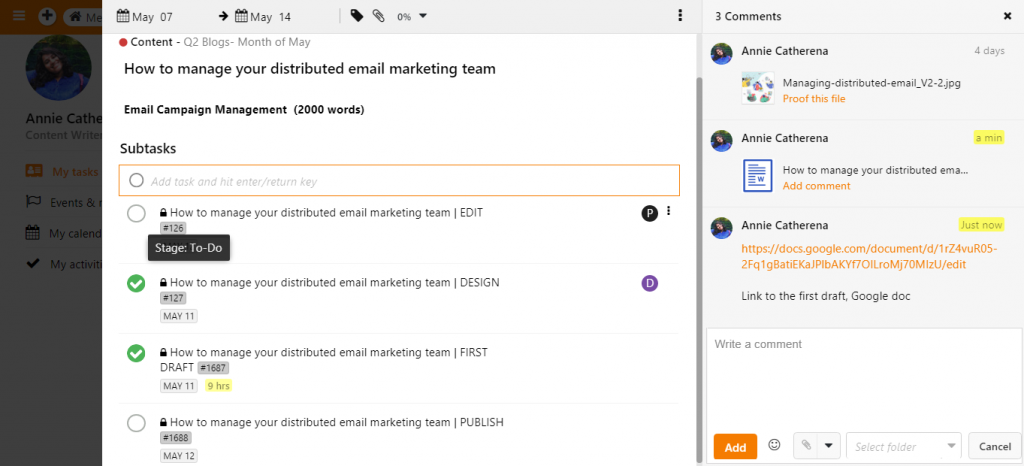Every organization would have come across these two instances- one where an employee wants to shift to a different city but wishes to continue with your organization and the other is when a talent that you want to recruit is not willing to relocate. An organization’s biggest challenge is to recruit and retain talent in today’s fast-moving world. Thanks to modern technology, connecting instantly across time zones is possible, eventually making remote working easier.
Especially during a crisis-like situation, where remote workspaces have become the need of the hour, many of us face a new challenge every day, be it the managers, email marketers, designers, or writers. Although communication is the biggest game-changer in such situations, there is much more to it. You will get a better insight as you read on.
Amidst all the tasks and goals to be met, an organization often forgets to strengthen the foundation on which the employment relationship is built. In a survey conducted by TINYpulse, it was found that remote employees were not only happier and overwhelmingly more productive than their on-location peers, but the companies also demonstrated a greater turnover and lower stress.
Things to keep in mind before going for a distributed email marketing team
1. Expectations
Your remote email marketing team will be working without your direct supervision, but you can certainly monitor the metrics of how they perform as individuals and as team players. This will help you in analyzing what responsibilities the employee will be able to handle and how efficiently. You will need to have practical expectations and accordingly assign tasks to avoid disappointments and delays in delivery. Speaking out loud about the company’s goals, their values and goals will send a clear message about what an employee is expected to do.
2. Responsibilities
Communication is one of the biggest responsibilities of an organization working with a remote email marketing team. Be it the tools the employees will be using or how they need to access the internet to keep company data secured or how they need to communicate within the team – all are very important for building an efficient remote team. It is the responsibility of an employee to complete their assigned tasks as per the schedule and be flexible about making modifications.
Challenges and how to overcome them
1. Keeping it Consistent
This issue grows with the size of the company. An organization that is larger in size will have more problems in keeping the brand voice consistent. While dealing with a distributed team, or when you outsource part of your email campaign, it might get a little overwhelming to make sure the brand message that is being delivered in the emails is kept the same throughout the customer journey.
Be it the brand colors, tone, or visualization – for smaller businesses, this issue can be resolved by communicating efficiently with the team. Laying out guidelines and having a uniform format for carrying out various functions will allow the team members to come back to the grail to see where they lack. You can start by streamlining your strategies and having a uniform marketing software which not only ensures that all the expectations, guidelines, and updates are communicated properly but also helps in monitoring endless chains of email campaigns.
2. Bridging the Technical Gap
Freelancers and outsourced teams often have the necessary applications and software to deliver assured standards of output. As their livelihood is entirely based upon their flexibility and compatibility with the foster company, such as marketing agencies and freelancers are well-equipped to meet their clients’ needs.
One of the common challenges that may occur is that of technical issues in delivering a task. Such situations should be anticipated and you should have an agreement of a back-up plan. The other issue is when a member or a team is making a transition from on-site to working remotely; there might be issues in adapting technically and upgrading or updating the employee’s assets accordingly. During this time, alternatives should be established so as to make sure no resources or productivity is going down the drain.
3. Adding value to campaigns
All marketing campaigns are data-driven and sometimes organizations get lost in the mass of data that flows in through email campaigns and other sources. While tracking all this data and analyzing its effectiveness might get chaotic, it may eventually lead to miscalculations regarding the success of a campaign. When you don’t have an effective campaign, where does all the spending on your resources go? To be more accountable for this, one should determine everything from customer behavioral response to ROI. This will help you stay on the right track and avoid campaigns that are ineffective in scope and revenue returns. Look for marketing strategies that deliver data and provide value to the brand.
4. Providing Support
In the survey conducted by TINY pulse, 27% reported work-related problems with the team as they were not present at the same place as their team. For instance, an employee misses an important update about a project because it was shared in a personal meeting.
In such cases it is very important that you not only provide the remote resource in your email marketing team equal privileges but also make sure you respond to their needs and address their issues. Supporting your employee, be it your remote or on-location team, will make them feel valued and respected. This will eventually lead to more productive hours and hassle-free work delivery. As face to face communication is not possible, the chances of a misunderstanding stand high. The solution is very simple, empathize with your employee and cut them some slack.
5. Ensuring Data Security
For an organization, one of the biggest insecurities is an employee accessing confidential files and leaking the data. On one hand our world is fuelled by information and powered by data and on the other, these insecurities are often labeled irrational but major security breaches have also been witnessed. Running a background check can help you ensure you are hiring the right person or agency.
Once within the organization, you can make your policies very clear and state the penalties of misusing data shared by the organization. If you are unsure about the acquaintances you share important data with, you may set sanctions for violation and prohibit it in the contract. Limiting and monitoring access, making an approval mandatory before accessing or sending any information may control the flow of information and avoid breaches.
6. Using Tools
When you work in an office, it is easier to monitor your email marketing team. For distributed teams, you can opt for tools like Proof Hub, Time Doctor, Slack to track productivity. Often, such collaboration tools are used for checking in on each other and staying connected. Communicate to the employees about the tool policies clearly. You need to convey that it is not about micromanagement or lack of trust but about being accountable for the time and productivity or to provide assistance if someone gets stuck.

Tips for effectively managing your distributed email marketing team
1. Communicate frequently (Formal and Informal)
The most important yet often overlooked process in an email marketing team is the process of briefing. The first step to this is to have a clear set of goals yourself and a timeline to go with it. Once this is strategized and looks feasible, you then communicate it to the particular person responsible for the task. At the same time, you should keep yourself open for queries, and make yourself available to deal with them. Your employee should feel comfortable to be able to communicate delays and issues to you. When you have to give out approvals or have the upper hand on something, try to be rational while communicating, an authoritarian tone often comes across as impolite.
2. Focus on results rather than rigid rules
Distributed teams are all about flexibility and increasing productivity. It is a well-known fact for one that micromanagement kills the remote working vibe, which affects the morale of employees. But marketers, too, need to proactively participate in communicating issues as discussed earlier. It might seem harder to control results and track them while working with a distributed team, but you also have to admit that just because an employee shares an office with you, it doesn’t mean they are productive. Discipline is a must and you need to ensure your remote team also believes the same.
3. Have clear and plausible goals
If you think your employee can read your mind or in-between the lines, you are being unrealistic. Face to face communication in an office makes lives easy, as the body language and expressions save you from any miscommunication or misunderstand an instruction. With a remote team, it’s different. You have to be clear while communicating. While employees need to know what to do, managers need to be precise in instructing and be realistic while giving tasks and deadlines.
4. Build trust
At the end of the day, a team that sits with you during lunch breaks or reminds you to log off from work is ultimately a group of human beings coming together for a mission. Team spirit and building a relationship based on trust and empathy will help the team be more open to each other and lead to better communications. Remember, the better your relationships, the easier it will be to resolve your issues. So trust your team and cut off the leash.
Wrap Up
It might be the first time in history that every organization has had to experiment with working remotely, but as an email marketing organization, this is not as alien as it is to many other professions. Today, even long presentations and round table conferences are being replaced by emails and video calls. Email strives to be the most functional and effective way of marketing and communicating in good times and bad.
We hope this blog would have not only made it a little easier to deal with the challenges in your distributed team but must have also given you a perspective of the best of both worlds, be it in the warmth of your colleagues at work or the comfort of your pajamas as you work from home.






Annie Catherena
Latest posts by Annie Catherena (see all)
All you need to know while hiring Marketo Email Specialist
5 Powerful Advantages of Salesforce Marketing Cloud for Financial Services Organizations